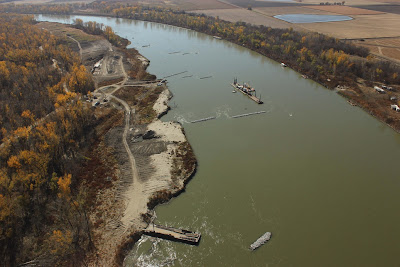In continuing to restore habitats along the Missouri River, the Army Corps of Engineers has several notable projects recently completed or underway.
Details for these projects were provided by Kelly Crane and Luke Wallace, both actively involved with the habitat restoration efforts by the Omaha District of the Corps.
Projects completed or underway, include:
1. Deer Island, on the Iowa side of the river at mile 672 (just above the confluence of the Little Sioux River), and located on property owned by the Iowa Department of Natural Resources: is a major channel top width widening project designed to create shallow water habitat along the main channel border. The top width of the river will be increased up to 400 feet in places to establish a "bench" of shallow water adjacent to the primary river channel. This project was started in 2012, and will be completed in 2014.
Deer Island project, October 2012. All images courtesy of the Army Corps of Engineers.
2. Sandy Point, on the Nebraska side of the river at mile 657, and completed in 2011: a new shallow water habitat was created that that consists of two chutes and multiple tie channels connecting the chutes to the river. The setting will provide an several features, according to Wallace, including an increase in the depth and flow diversity of the off-channel river waters, create more edge habitat and provide places for woody debris piles to develop.
Sandy Point project, October 2012.
"This is a complex project not like any that have been previously done," said Wallace, especially noting it is "unique for having two chutes. It is like a research project," with extensive preliminary modeling done to determine the best method of implementation. Physical and biological monitoring will be done to evaluate the results, he said.
3. Tobacco Island, at river mile 588: a modification to an existing chute to change the location of the inlet and route the chute away from a rocky outcropping to allow the chute develop over the years as designed. This project is at the William Gilmore WMA, just downstream from Plattsmouth. The first chute created could not widen as intended due to the rock strata near the bluffs, so a chute is being dredged further to the east and closer to the river. The first chute will revert to backwater habitat, Crane said.
Tobacco Island project, October 2012.
Other smaller projects required due to changes in channel features caused by the 2011 flood, were done at Fawn Island, Middle Decatur Bend, and Tyson Bend, said Wallace. This primarily involved dredging to reconnect features to the river hydrology.
The corps plans to work on the following project in the coming months, Crane said.
1. Little Sioux Bend, in Nebraska at river mile 668: "create a chute with multiple tie channels similar to the Sandy Point project.
Little Sioux Bend project site, October 2012. | Little Sioux Bend project design, October 2012. |
2. Boyer/DeSoto National Wildlife Refuge, on the Iowa side of the Missouri at river mile 644: a shallow water feature will be created on refuge lands, in conjunction with the U.S. Fish and Wildlife Service. A planning meeting for this project occurred November 9th.
3. Glover's Point, on the Nebraska side of the river on Winnebago Tribe land at river mile 712: a backwater area will be established, including a connection to river hydrology, to what had been a chute project. High river flows in 2011 blocked the upstream end of the chute, Crane said. The Corps is working with members of the Winnebago Tribe to revise the project features.
Each of these projects are required to mitigate the loss of habitat due to construction of the Missouri River Bank Stabilization and Navigation Project.
Project Evaluation
A reconnaissance to evaluate the status of the river and mitigation projects from Rulo, Neb. to Sioux City, IA, occurred on October 16-17th.
Fifteen people participating in the helicopter flights included Corps engineers, biologists and construction representatives responsible if the design and function of the projects, along with representatives of the Iowa Department of Natural Resources and Nebraska Game and Parks Commission.
They had an opportunity to look at different construction, hydrology, recovery and environmental components along the river, according to Wallace. And to in particular:
- evaluate current river conditions subsequent to the 2011 flood;
- determine the status of site repairs done earlier in the year to repair flood damage;
- review work completed or underway at project sites;
- see where levee repairs had been done, and to get a perspective of the borrow sites where dirt was removed to repair the levee structures. In some cases, where public land was available, the levees were moved a further distance from the primary river channel. At other sites, the excavation of dirt necessary for the new levees, meant new wetland habitat was developed, with hundreds of acres created overall.
- consider locations for potential new projects.
During the survey, thousands of documentary photographs were taken that visually convey the river condition setting along the entire distance.
These flights, done every October, "provide a great perspective and a good overview," Crane said. "They are beneficial because they allow those responsible for the projects to see them all in one day. The two state agencies are very important partners with the Corps and participate in selecting, planning and designing projects" in their states. The National Park Service is also a partner, along the Missouri National Recreation River, above Ponca State Park.




